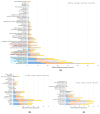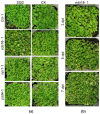cDNA Transcriptome of Arabidopsis Reveals Various Defense Priming Induced by a Broad-Spectrum Biocontrol Agent Burkholderia sp. SSG
- PMID: 35328570
- PMCID: PMC8954528
- DOI: 10.3390/ijms23063151
cDNA Transcriptome of Arabidopsis Reveals Various Defense Priming Induced by a Broad-Spectrum Biocontrol Agent Burkholderia sp. SSG
Abstract
Burkholderia sp. SSG is a potent biological control agent. Even though its survival on the leaf surface declined rapidly, SSG provided extended, moderate plant protection from a broad spectrum of pathogens. This study used Arabidopsis Col-0 and its mutants, eds16-1, npr1-1, and pad4-1 as model plants and compared treated plants with non-treated controls to elucidate whether SSG triggers plant defense priming. Only eds16-1 leaves with SSG became purplish, suggesting the involvement of salicylic acid (SA) in SSG-induced priming. cDNA sequencing of Col-0 plants and differential gene expression analysis identified 120 and 119 differentially expressed genes (DEGs) at 6- and 24-h post-treatment (hpt) with SSG, respectively. Most of these DEGs encoded responses to biotic and abiotic stimuli or stresses; four DEGs had more than two isoforms. A total of 23 DEGs were shared at 6 and 24 hpt, showing four regulation patterns. Functional categorization of these shared DEGs, and 44 very significantly upregulated DEGs revealed that SSG triggered various defense priming mechanisms, including responses to phosphate or iron deficiency, modulation of defense-linked SA, jasmonic acid, ethylene, and abscisic acid pathways, defense-related gene regulation, and chromatin modification. These data support that SSG is an induced systemic resistance (ISR) trigger conferring plant protection upon pathogen encounter.
Keywords: Arabidopsis; Burkholderia sp.; Oxford Nanopore Technology (ONT) sequencing; biocontrol agent; cDNA transcriptome; defense priming; induced systemic resistance (ISR); leaf endophyte; systemic acquired resistance (SAR).
Conflict of interest statement
The authors declare no conflict of interest. The funders had no role in the design of the study, in the collection, analyses, or interpretation of data; in the writing of the manuscript, or in the decision to publish the results.
Figures





Similar articles
-
Enhanced defense responses in Arabidopsis induced by the cell wall protein fractions from Pythium oligandrum require SGT1, RAR1, NPR1 and JAR1.Plant Cell Physiol. 2009 May;50(5):924-34. doi: 10.1093/pcp/pcp044. Epub 2009 Mar 20. Plant Cell Physiol. 2009. PMID: 19304739
-
Enhancement of induced disease resistance by simultaneous activation of salicylate- and jasmonate-dependent defense pathways in Arabidopsis thaliana.Proc Natl Acad Sci U S A. 2000 Jul 18;97(15):8711-6. doi: 10.1073/pnas.130425197. Proc Natl Acad Sci U S A. 2000. PMID: 10890883 Free PMC article.
-
Plastic Transcriptomes Stabilize Immunity to Pathogen Diversity: The Jasmonic Acid and Salicylic Acid Networks within the Arabidopsis/Botrytis Pathosystem.Plant Cell. 2017 Nov;29(11):2727-2752. doi: 10.1105/tpc.17.00348. Epub 2017 Oct 17. Plant Cell. 2017. PMID: 29042403 Free PMC article.
-
NPR1 in JazzSet with Pathogen Effectors.Trends Plant Sci. 2018 Jun;23(6):469-472. doi: 10.1016/j.tplants.2018.04.007. Epub 2018 May 9. Trends Plant Sci. 2018. PMID: 29753632 Review.
-
Systemic propagation of immunity in plants.New Phytol. 2021 Feb;229(3):1234-1250. doi: 10.1111/nph.16953. Epub 2020 Oct 24. New Phytol. 2021. PMID: 32978988 Review.
Cited by
-
Hub Genes and Pathways Related to Lemon (Citrus limon) Leaf Response to Plenodomus tracheiphilus Infection and Influenced by Pseudomonas mediterranea Biocontrol Activity.Int J Mol Sci. 2024 Feb 17;25(4):2391. doi: 10.3390/ijms25042391. Int J Mol Sci. 2024. PMID: 38397068 Free PMC article.
-
Characterization of the Soil Bacterial Community from Selected Boxwood Gardens across the United States.Microorganisms. 2022 Jul 26;10(8):1514. doi: 10.3390/microorganisms10081514. Microorganisms. 2022. PMID: 35893572 Free PMC article.
-
Differential gene expression analysis under salinity stress in the selected turmeric (Curcuma longa L.) cultivars for curcuminoid biosynthesis.Mol Biol Rep. 2023 Dec;50(12):9745-9753. doi: 10.1007/s11033-023-08719-4. Epub 2023 Sep 2. Mol Biol Rep. 2023. PMID: 37658929
-
Amphibian skin bacteria display antifungal activity and induce plant defense mechanisms against Botrytis cinerea.Front Plant Sci. 2024 Apr 9;15:1392637. doi: 10.3389/fpls.2024.1392637. eCollection 2024. Front Plant Sci. 2024. PMID: 38654899 Free PMC article.
-
Revealing Genetic Differences in Fiber Elongation between the Offspring of Sea Island Cotton and Upland Cotton Backcross Populations Based on Transcriptome and Weighted Gene Coexpression Networks.Genes (Basel). 2022 May 26;13(6):954. doi: 10.3390/genes13060954. Genes (Basel). 2022. PMID: 35741716 Free PMC article.
References
-
- O’Brien P.A. Biological control of plant diseases. Australas. Plant Pathol. 2017;46:293–304. doi: 10.1007/s13313-017-0481-4. - DOI
MeSH terms
Substances
Grants and funding
LinkOut - more resources
Full Text Sources
Miscellaneous

